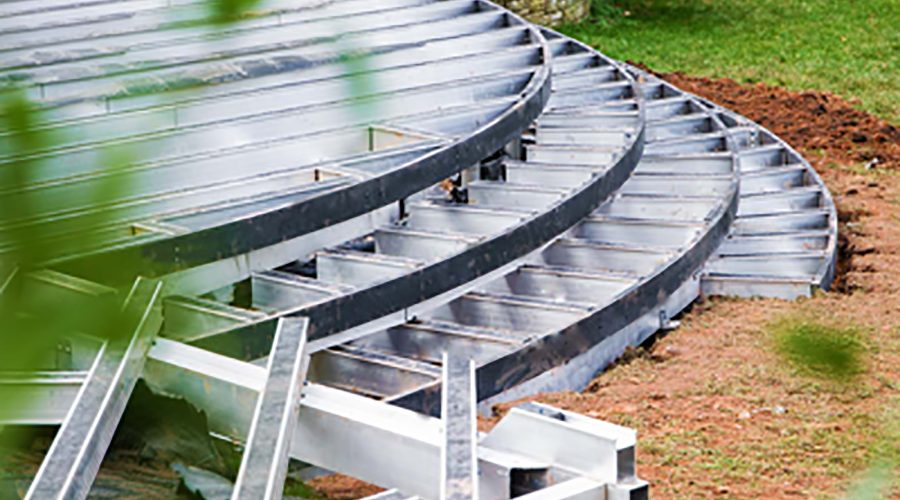If you’re looking to build a decking project that is going to stand the test of time, the subframe of a decking area is one of the most important parts. Whilst the subframe is generally hidden, it is crucial for the deck’s longevity.
Millboard
A poor subframe choice or install can lead to the decking being damaged or can even lead to the decking becoming structurally dangerous and eventually failure. With so many different subframes to choose from, which one is best and what should you look out for? Here we look at 3 options:
Timber Subframes
Softwood timber is the most common material used for decking subframes. Timber is easy to work with, generally readily available, and is a naturally strong product with a high strength-to-weight ratio. When correctly specified and installed, timber subframes can have a long service life.
However, there have been many cases of timber subframes that have failed within 6 years of being installed, often because of a lack of understanding of the requirements of timber, incorrect timber being used in the wrong location and bad workmanship. Timber is inclined to rot and care must be taken to ensure the structure is adequately ventilated. It is a common belief that ‘all treated timber is suitable for decking subframes’, however, this is incorrect as the classification of pressure treatment can make a big difference on the longevity of the frame. For example, an ‘interior-grade’ Use Class 2 (UC2) pressure treated timber may look the same as an ‘exterior-grade’ Use Class 4 (UC4) pressure treated timber, however they carry very different classifications and are designed for use in different locations.
Detailed guidance on the installation of timber subframes is readily available from industry professional organisations such as The WPA (Wood Protection Association) and TDCA (Timber Decking and Cladding Association), written from years of experience and testing. For more detailed information please consult our Guide to Decking Subframes.
Plas-Pro Subframes
Plas-Pro is an excellent alternative to timber for constructing the framework for decks, seating, planters and more. Constructed from recycled plastic, Plas-Pro is strong, versatile and easy to work with. Available in a range of sizes to act as posts, joists and bearers, it can be fitted in a similar way to wood yet never rots, even when placed in water.
The benefits of Plas-Pro over timber are that Plas-Pro can be used in contact with the ground and in water without the need for any airflow ventilation gaps; it can be sunk into the ground and surrounded fully with moisture without adverse effect. Being a non-rot system, Plas-Pro can be used in areas where the subframe is likely to constantly get wet, such as areas around swimming pools, areas in boggy marshland, areas over lakes/ponds and other similar environments. It is also the ideal solution for subframes over roof terraces where heights are reduced and therefore ventilation is closed off, as timber would have a higher chance of rotting.
Plas-Pro is similar to timber in that it can be cut, drilled, fixed into and bolted, making it an easy framework for building planters, seating, flowerbeds or other small outdoor structures. As Plas-Pro is made from recycled plastic there are a number of points to bear in mind when using it for your subframe, we recommend consulting our detailed specification.
DuoSpan Subframes
DuoSpan is a unique landscape construction frame, it is made with a combination of aluminium joists and beams, aluminium brackets and plastic support profiles. This combination enables distinctive design opportunities for decking and outdoor structures that would be impossible with timber subframes, due to the superior strength of aluminium and flexibility of plastic.
Being made from aluminium, the joists are resistant to rotting or moisture ingress, negating the need for airflow gaps to the framework or end-grain preservative treatment. With other solutions, the profiles aren’t always straight, leading to numerous noggins being required to help in the installation, whereas with DuoSpan the aluminium joists and beams are almost perfectly straight, resulting in a faster install.
The DuoSpan subframe system comes with a range of fixed and flexible brackets that allow the components to be connected at almost any angle these brackets are uniquely designed to fit perfectly into the side of the joist, helping each joint sit flush. Screw-locating grooves on the side of the joists and self-drilling screws ensure fast, consistent fitting. The self-drilling screws provided with the brackets are made from A4 marine-grade stainless steel and they are coated in a cathodic barrier coating to minimise the potential for galvanic corrosion between the aluminium and stainless steel.
DuoSpan is built to comply with Eurocode 1: Actions on Structures (BS EN 1991-1-1). The joists and beams can achieve increased spans of up to 1.8m and can cantilever up to 600mm*, both comparably larger than that of timber or plastic subframes. The DuoSpan joists and beams can be cut in a similar way to timber with an aluminium cutting blade, standard carpentry tools are used in fitting the framework together. Full installation details can be found on DuoSpan.
In conclusion, timber, recycled plastic (Plas-Pro) and aluminium (DuoSpan) subframes all have different attributes and being familiar with the benefits of each and knowing what to use and when can add years to the deck’s longevity. For more information on Plas-Pro and DuoSpan, there is an extensive Help and Advice section for professionals on our website.
*Please refer to our loading tables for the full lists of spans in the required locations








